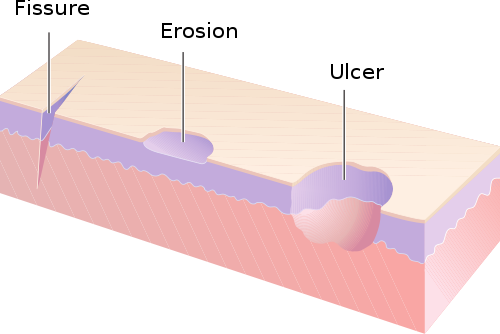Difference Between Fistula and Fissure
A fistula is a connection that is created between two regions where there should be no such connection. A fissure is a tear that commonly occurs in the epithelial layer of the skin of the anal canal.
What is Fistula?
Definition:
The fistula is a connection that is created connecting one region to another and is not supposed to be present in the human body. Fistulas commonly form between the anus and the skin or vagina and the rectum.

Symptoms and prevention:
A fistula between the anus and rectum has symptoms such as pain and also a foul-smelling discharge is often present. The rectovaginal fistula forms between the vagina and rectum and thus will often have symptoms related to the passage of feces into the vagina, which can lead to infections and a foul-smelling discharge from the vaginal canal.
Diagnosis and causes:
Fistulas are detected by means of a physical exam and sometimes by means of a CT scan. A contrast medium can be injected as well in order to see if contents are leaking into the skin or vagina if a doctor is uncertain about the presence of a fistula. Childbirth or various inflammatory bowel conditions such as Crohn’s disease can often cause a fistula to develop.
Risk factors and treatment:
Risk factors for the development of a fistula include having Crohn’s disease or even having problems giving birth. Surgical intervention is often needed to correct the fistula. When surgery is done, any infected material present has to be removed first before closing the connection to ensure that no systemic infection develops.

What is Fissure?
Definition:
A fissure is a name for a tear that sometimes occurs in the outer layer of the tissue of the anal canal. This outermost tissue layer in this region is made of squamous epithelial cells.
Symptoms and prevention:
The presence of an anal fissure is often made known by pain and also sometimes bleeding, especially when the person has a bowel movement, after which the pain does lessen.
Diagnosis and causes:
A physical examination noting the presence of the tear in the posterior or anterior middle part of the anal canal leads to the diagnosis of the condition. The cause of a tear can be from having an inflammatory bowel disease and straining during defecation or from passing large stools or problems during childbirth.
Risk factors and treatment:
Risk factors for the development of anal fissures include having Crohn’s disease and straining during defecation due to constipation. Having a difficult childbirth experience can also lead to tearing, and the development of a fissure. The fissures can be treated using various ointments and also by taking sitz baths for 10 minutes or so can be helpful. It is also a good idea for patients to take stool softeners, to prevent straining during defecation. Ointments such as 2% nitroglycerin can be helpful as can 2% diltiazem gel or 0.25 nifedipine ointment.
Difference between Fistula and Fissure?
Definition
A fistula is defined as some type of connection between two regions that should not be present. A fissure is a tear that happens in the middle region of the skin of the anal canal.
Symptoms
Fistulas become evident when a person experiences a bad-smelling discharge and sometimes pain. An anal fissure is most often noticed when a person has pain upon defecation, and on occasion, bleeding.
Causes
Problems during childbirth and inflammation of the bowels can lead to the formation of a fistula. Straining during defecation or bowel inflammation and childbirth difficulties can produce an anal fissure.
Risk factors
Some risk factors for developing a fistula are having Crohn’s disease or problems giving birth. Risk factors for creating a fissure include straining during defecation because of constipation and also having an inflammatory bowel problem or difficult childbirth.
Treatment
Surgery is often the treatment of choice for correcting fistulas. Fissures can be treated by applying various ointments such as 2% nitroglycerin can be helpful, as can 2% diltiazem gels or 0.25 nifedipine ointment, and having warm sitz baths, and using stool softeners is also a good idea.
Prevention
Preventing fistulas from forming is difficult but treating and controlling bowel inflammation is a good first step. Using stool softeners and preventing straining during defecation can help to prevent fissures from being created, and inflammatory bowel problems should be controlled.
Table comparing Fistula and Fissure

Summary of Fistula Vs. Fissure
- Both a fistula and fissure can form in the anal region of the body.
- Difficulty during childbirth can be a cause of either fistulas or fissures in women.
- Both a fissure and fistula can be painful conditions that require treatment.
- A fistula is treated best by means of a surgery in which the actual tunnel between the areas is closed.
- A fissure can heal on its own and thus is best treated by various ointments and using stool softeners.
- The fistula and fissure are both conditions that can be as a result of having poorly managed Crohn’s disease.
- Difference Between Rumination and Regurgitation - June 13, 2024
- Difference Between Pyelectasis and Hydronephrosis - June 4, 2024
- Difference Between Cellulitis and Erysipelas - June 1, 2024
Search DifferenceBetween.net :
Leave a Response
References :
[0]Image credit: https://upload.wikimedia.org/wikipedia/commons/thumb/0/06/Ulcers%2C_fissures%2C_and_erosions.svg/500px-Ulcers%2C_fissures%2C_and_erosions.svg.png
[1]Image credit: https://upload.wikimedia.org/wikipedia/commons/thumb/c/c0/Radiocephalic_fistula.svg/500px-Radiocephalic_fistula.svg.png
[2]Ansari, Parswa . “Anorectal fistula”. Merckmanuals. Merck & Co., 2018, https://www.msdmanuals.com/professional/gastrointestinal-disorders/anorectal-disorders/anorectal-fistula
[3]Ansari, Parswa . “Anal fissure”. Merckmanuals. Merck & Co., 2018, https://www.msdmanuals.com/professional/gastrointestinal-disorders/anorectal-disorders/anal-fissure
[4]Jordán, J., et al. "Risk factors for recurrence and incontinence after anal fistula surgery." Colorectal Disease 12.3 (2010): 254-260.
